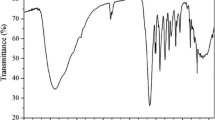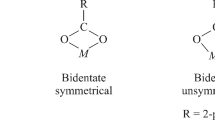Abstract
The crystal structure of [Cu(HBPA)2]Cl2·4H2O [HBPA = (2-hydroxybenzyl-2-pyridylmethyl)amine] revealed an octahedral geometry around Cu(II). The mononuclear complex crystallizes in the triclinic space group P21/n with cell lengths of a = 7.3705 (6), b = 9.7695 (6), c = 20.2314 (15) Å and with cell angles of α = 90, β = 100.264 (3) and γ = 90º. The coordination plane is comprised of two secondary amine and two pyridine nitrogens, the phenol oxygen atoms are coordinated in the protonated form and occupy the axial sites. Investigations in solution (MeOH and DMF) by electronic spectroscopy and electrochemical studies suggest effect of the solvents on the structure, indicating the partial coordination of the axial ligands as phenolate, resulting in the formation of distinct species in solution. Addition of base enables the effective coordination of phenol group as phenolate, as observed by the increase of the intensity of the band at 429 nm and the formation one only compound in DMF solution, according to cyclic voltammetry studies.
Graphical Abstract
Herein we describe the crystal structure of [Cu(HBPA)2]Cl2·4H2O [HBPA = (2-hydroxybenzyl-2-pyridylmethyl)amine].The coordination plane is comprised of two secondary amine and two pyridine nitrogens, the phenol oxygen atoms are coordinated in the protonated form and occupy the axial sites. Investigations in solution by electronic spectroscopy and electrochemical studies suggest effect of the solvent; the addition of base enables the effective coordination of phenol group as phenolate, resulting in one only compound in solution.









Similar content being viewed by others
References
Fontecave M, Pierre J-L (1998) Coord Chem Rev 170:125–140
Fontecave M, Eklund H (1995) Structure 11:1127–1129
John A, Shaikh MM, Ghosh P (2008) Dalton Trans 21:2815–2824
McCann M, Santos ALS, da Silva BA, Romanos MTV, Pyrrho AS, Devereux M, Kavanagh K, Fichtner I, Kellett A (2012) Toxicol Res 1:47–54
Safi R, Nelson ER, Chitneni SK, Franz KJ, George DJ, Zalutsky MR, McDonnell DP (2014) Cancer Res 74(20):5819–5831
Hickey JL, Donnelly PS (2012) Coord Chem Rev 256:2367–2380
Paterson BM, Donnelly PS (2011) Chem Soc Rev 40(5):3005–3018
Uma R, Viswanathan R, Palaniandavar M, Lakshminarayanan M (1994) Dalton Trans 8:1219–1226
Neves A, Vencato I, Verani CN (1996) Acta Cryst C52:1648–1651
Neves A, Verani CN, de Brito MA, Mangrich AS, Oliva G, Souza DDHF, Batista AA (1999) Inorg Chim Acta 290:207–212
Bruker (2014) APEX2. Bruker AXS Inc., Madison
Dolomanov OV, Bourhis LJ, Gildea RJ, Howard JAK, Puschmann H (2009) J Appl Cryst 42:339–341
Sheldrick GM (2008) Acta Cryst A64:112–122
Reis ACM, Freitas MCR, Resende JALC, Diniz R, Rey N (2014) J Coord Chem 67:3067
Geary WJ (1971) Coord Chem Rev 7:81–122
Acknowledgments
The authors are grateful to financial support received from FAPERJ (Fundação de Amparo à Pesquisa do Estado do Rio de Janeiro) and CNPq (Conselho Nacional de Desenvolvimento Científio e Tecnológico).
Author information
Authors and Affiliations
Corresponding author
Electronic supplementary material
Below is the link to the electronic supplementary material.
Rights and permissions
About this article
Cite this article
Azeredo, N.F.B., Bull, E.S., Resende, J.A.L.C. et al. Crystal Structure and Behavior in Solution of [Cu(HBPA)2]Cl2·4H2O [HBPA = (2-hydroxybenzyl-2-pyridylmethyl)amine]. J Chem Crystallogr 45, 476–483 (2015). https://doi.org/10.1007/s10870-015-0617-8
Received:
Accepted:
Published:
Issue Date:
DOI: https://doi.org/10.1007/s10870-015-0617-8




